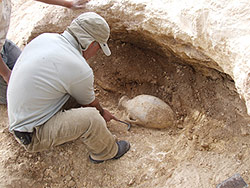
Funerary offerings found at the site
A previously unknown burial field more than 4,000 years old was exposed beneath the spot where the Second Temple Model used to be exhibited, next to the Holy Land Hotel, in Jerusalem.
In salvage excavations the Israel Antiquities Authority is conducting in the Holy Land Park construction project in Jerusalem, in the place where the “Model of Jerusalem from the time of the Second Temple” was once displayed, a burial field more than 4,000 years old was uncovered. The cemetery is unique and rich in finds. The site is located at the end of the hill where the Beit Ve’Gan neighborhood is situated and looks out over ‘Emeq Rephaim, in the vicinity of Malha and “Teddy” Stadium.
The directors of the excavation on behalf of the Israel Antiquities Authority, Dr. Ianir Milevski and Zvi Greenhut, reported that “the cemetery extends across more than two dunams, and based on the evidence at the site burials were conducted there for many generations, particularly in the Bronze Age, between the years 2200-2000 BCE and 1700-1600 BCE”.
A wealth of artifacts has been recovered from the cemetery including scarabs that were used as amulets – an imitation of Egyptian scarabs; metal objects – among them weapons and tools; jewelry and intact high quality pottery vessels that were meticulously manufactured. Together with the human bones that were found there were also animal bones consisting mostly of sheep and goats. All of the artifacts served as funerary offerings and the animals and food that the pottery vessels probably contained are referred to in archaeological literature as “food for the dead”. According to Dr. Milevski, the importance of the excavation’s findings lies in the contribution they provide in increasing our knowledge about these periods in the rural region near Canaanite Jerusalem. “All of Jerusalem’s agricultural hinterland c. 4,000 and c. 3,700 years ago was much greater than we have previously considered”, Milevski added.
Additional Articles ...